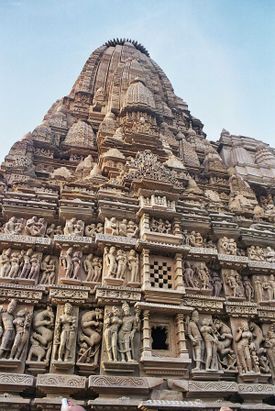Khajuraho Group of Monuments
| UNESCO World Heritage Site | |
|---|---|
 | |
| Criteria | Cultural: i, iii |
| Reference | 240 |
| Inscription | 1986 (10th session) |
Khajuraho (Template:Lang-hi) is a village in the Indian state of Madhya Pradesh, located in Chhatarpur District, about 385 miles (620 kilometres) southeast of Delhi, the capital city of India.
The Khajuraho group of monuments has been listed as a UNESCO World Heritage Site.
One of the most popular tourist destinations in India, Khajuraho has the largest group of medieval Hindu and Jain temples, famous for their erotic sculpture. The name Khajuraho is derived from the Hindi word khajur meaning date palm.
History
The city was once the original capital of the Chandela Rajputs, a Hindu dynasty that ruled this part of India from the 10th to the 12th centuries. The Khajuraho temples were built over a span of a hundred years, from 950 to 1050. The Chandela capital was moved to Mahoba after this time, but Khajuraho continued to flourish for some time.
The whole area was enclosed by a wall with eight gates, each flanked by two golden palm trees. There were originally over 80 Hindu temples, of which only 22 now stand in a reasonable state of preservation, scattered over an area of about 8 square miles (21 km²).
Unlike other cultural centers of North India, the temples of Khajuraho never underwent massive destruction by early Muslim invaders between c. 1100-1400 AD. Due to overgrowth following their abandonment, a number of them survived to be discovered by the British in the 19th century. The colonials undertook the laborious excavation of the temples, which required no small amount of reassembly. Today, the temples serve as fine examples of Northern Indian architectural styles that ha